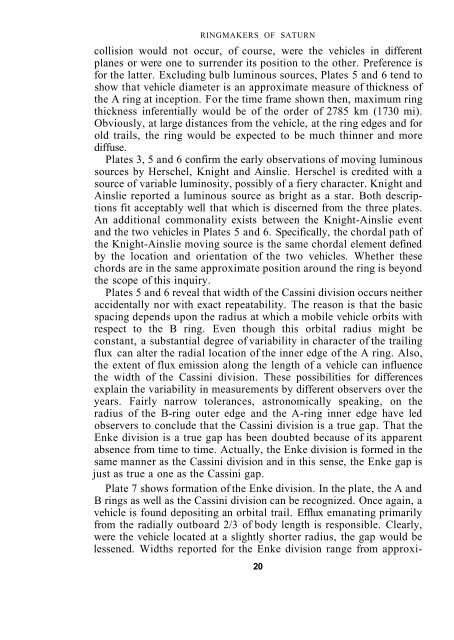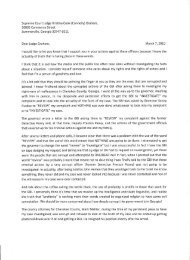Ringmakers of Saturn PDF - Patrick Crusade
Ringmakers of Saturn PDF - Patrick Crusade
Ringmakers of Saturn PDF - Patrick Crusade
Create successful ePaper yourself
Turn your PDF publications into a flip-book with our unique Google optimized e-Paper software.
RINGMAKERS OF SATURN<br />
collision would not occur, <strong>of</strong> course, were the vehicles in different<br />
planes or were one to surrender its position to the other. Preference is<br />
for the latter. Excluding bulb luminous sources, Plates 5 and 6 tend to<br />
show that vehicle diameter is an approximate measure <strong>of</strong> thickness <strong>of</strong><br />
the A ring at inception. For the time frame shown then, maximum ring<br />
thickness inferentially would be <strong>of</strong> the order <strong>of</strong> 2785 km (1730 mi).<br />
Obviously, at large distances from the vehicle, at the ring edges and for<br />
old trails, the ring would be expected to be much thinner and more<br />
diffuse.<br />
Plates 3, 5 and 6 confirm the early observations <strong>of</strong> moving luminous<br />
sources by Herschel, Knight and Ainslie. Herschel is credited with a<br />
source <strong>of</strong> variable luminosity, possibly <strong>of</strong> a fiery character. Knight and<br />
Ainslie reported a luminous source as bright as a star. Both descriptions<br />
fit acceptably well that which is discerned from the three plates.<br />
An additional commonality exists between the Knight-Ainslie event<br />
and the two vehicles in Plates 5 and 6. Specifically, the chordal path <strong>of</strong><br />
the Knight-Ainslie moving source is the same chordal element defined<br />
by the location and orientation <strong>of</strong> the two vehicles. Whether these<br />
chords are in the same approximate position around the ring is beyond<br />
the scope <strong>of</strong> this inquiry.<br />
Plates 5 and 6 reveal that width <strong>of</strong> the Cassini division occurs neither<br />
accidentally nor with exact repeatability. The reason is that the basic<br />
spacing depends upon the radius at which a mobile vehicle orbits with<br />
respect to the B ring. Even though this orbital radius might be<br />
constant, a substantial degree <strong>of</strong> variability in character <strong>of</strong> the trailing<br />
flux can alter the radial location <strong>of</strong> the inner edge <strong>of</strong> the A ring. Also,<br />
the extent <strong>of</strong> flux emission along the length <strong>of</strong> a vehicle can influence<br />
the width <strong>of</strong> the Cassini division. These possibilities for differences<br />
explain the variability in measurements by different observers over the<br />
years. Fairly narrow tolerances, astronomically speaking, on the<br />
radius <strong>of</strong> the B-ring outer edge and the A-ring inner edge have led<br />
observers to conclude that the Cassini division is a true gap. That the<br />
Enke division is a true gap has been doubted because <strong>of</strong> its apparent<br />
absence from time to time. Actually, the Enke division is formed in the<br />
same manner as the Cassini division and in this sense, the Enke gap is<br />
just as true a one as the Cassini gap.<br />
Plate 7 shows formation <strong>of</strong> the Enke division. In the plate, the A and<br />
B rings as well as the Cassini division can be recognized. Once again, a<br />
vehicle is found depositing an orbital trail. Efflux emanating primarily<br />
from the radially outboard 2/3 <strong>of</strong> body length is responsible. Clearly,<br />
were the vehicle located at a slightly shorter radius, the gap would be<br />
lessened. Widths reported for the Enke division range from approxi-<br />
20



